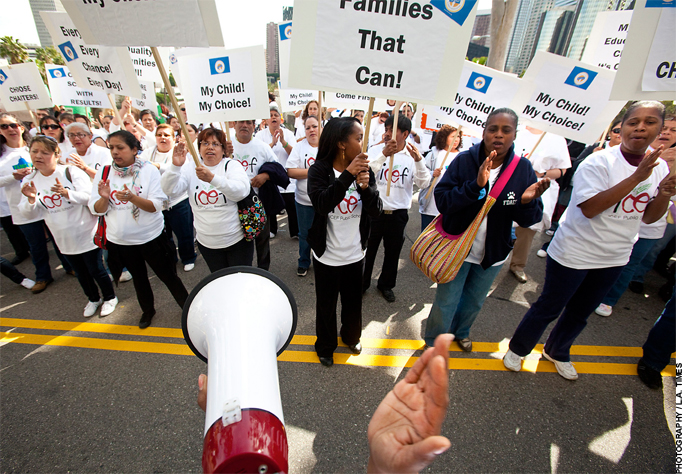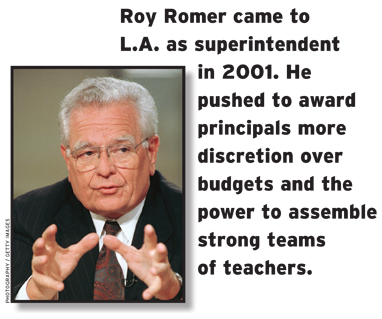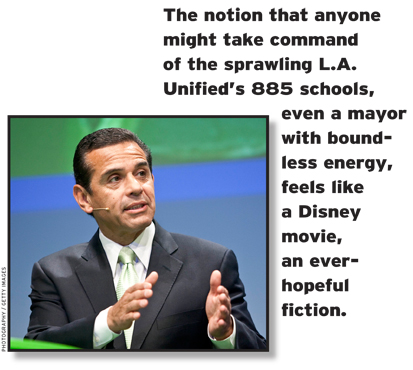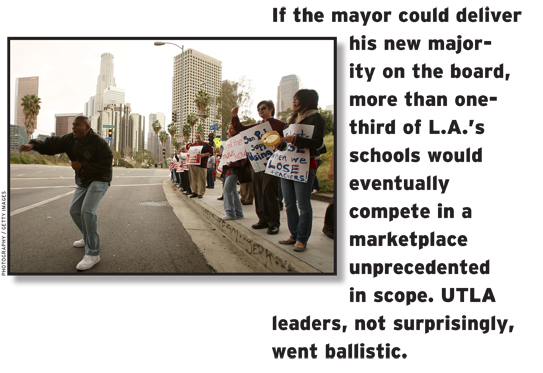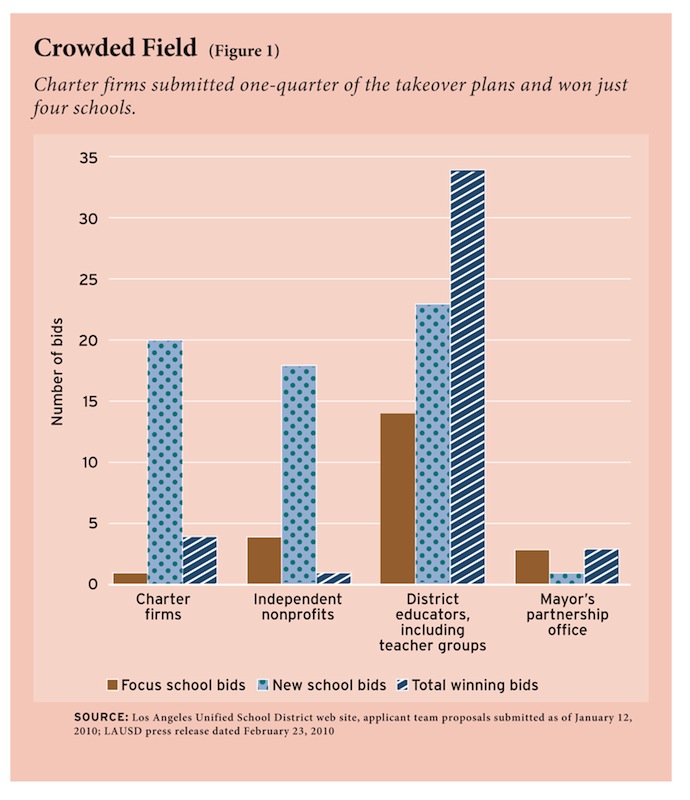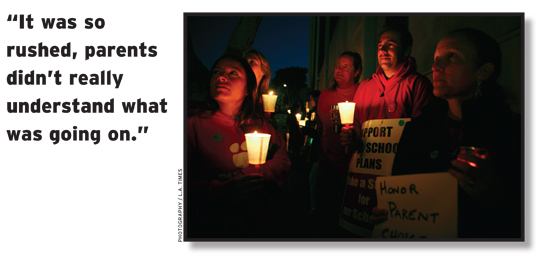Antonio Villaraigosa, the handsome high-voltage mayor of Los Angeles, really comes alive when recalling his start in local politics—as a labor organizer agitating for reform inside decrepit and overcrowded schools. “I cut my teeth working for the union. I cultivated these young teachers who had come to these schools to change the world,” he said, brimming with pride.
Back in 1989, one of those teachers, Joshua Pechthalt, joined Villaraigosa for a rally downtown in Exposition Park. Pechthalt remembers his charismatic young friend pumping up the crowd. “Antonio was the master of ceremonies who had parents and teachers on their feet,” recalled Pechthalt, now vice president of United Teachers Los Angeles (UTLA). “When we see each other, to this day, we give each other a hug.”
By 1994, the popular Villaraigosa was departing for the state capitol, rocketed into a legislative seat by grateful teachers, not to mention the union’s campaign contributions. Fellow legislators chose Villaraigosa to become the first-ever Latino Speaker. Back home in East Los Angeles, the teachers associations would spend over $1 million during his six-year tenure in Sacramento to ensure that Villaraigosa would be reelected.
“As Speaker, I was without question the number one advocate for the unions,” Villaraigosa reminisced. Teacher pay hikes sailed through the legislature. He made sure that the push to hold educators accountable for results stopped short of challenging protection of dismal teachers and stymied efforts to send strong teachers into weak schools.
Fast-forward to 2010 and Villaraigosa finds himself in the vortex of a political torrent. “I’m Public Enemy Number One within the UTLA,” he told me. In his quest to turn around the schools, the mayor has united working-class Latino parents, civil rights leaders, and big-money Democrats to challenge union leaders. “It’s been a war,” he said. “It’s a war I’m willing to wage.” After a series of bloody battles against his old union friends, including a 2007 loss in the courts, the mayor gained the upper hand last fall when the L.A. school board passed a radical reform plan that he helped to craft. Over the next few years, the district intends to hand off one-third of its 800-plus campuses to managers of charter schools, other nonprofits, and inventive district educators.
Democratic leaders have enriched the unions over the past half century, creating millions of jobs for dues-paying teachers, feeding the building trades via school construction, and granting bargaining rights to teachers in the 1970s. But union leaders, of late, find themselves on the far edge of the national debate over how to lift students and their flagging schools. Test scores have largely stalled in recent years and gaps have widened slightly, according to the National Assessment of Educational Progress.
Labor chiefs are openly miffed over President Obama’s offer of moral support and billions of federal dollars to escalate the “war” being waged by Villaraigosa and his fellow mayors. “In a place like L.A. or Detroit, where the public schools are dysfunctional,” Secretary of Education Arne Duncan told me, “I don’t think that the system can by itself go where it has to go. You have to rally all elements of the community. The person who can rally all those actors is the mayor.”
Villaraigosa is not the only city chief to take charge of urban schools. But his battle for mayoral control in Los Angeles offers a cautionary tale for all sides. It reveals new tensions between teachers union leaders and Democratic mayors. But charter school enthusiasts should not expect that close alliance, nurtured over many years, to be disrupted overnight. Politicians are highly skilled at finding a middle ground between demands for reform and protection of old connections. As much as Villaraigosa—and the school superintendent with whom he is allied—have appeared committed to rapid charter school expansion, when the L. A. school board took decisive action in February, charters were forced to settle for much less than they expected. Instead of getting the lion’s share of the schools they sought, charters were left with only four. Newly formed teacher groups won the vast majority of school contracts after they formed an alliance with UTLA. The charters were left with their tongues hanging out.
The Players
Villaraigosa returned to L.A. in 2000, eager to become the city’s first Latino mayor since 1872. His union friends contributed another $2 million in traceable dollars to his mayoral campaigns in 2001 and 2005. Leaders of the California Teachers Association even talked up Villaraigosa as California’s next photogenic governor, the Democratic heir apparent to Republican Arnold Schwarzenegger.
At first, the old polarities seemed to hold, pitting education groups like the UTLA against downtown developers and fiscal conservatives. Then the mayor began to echo the impatience expressed by blue-collar Latino parents, packed into graying apartments and tiny cottages spread across East Los Angeles. For decades these families saw no options other than sending their children to overcrowded, sometimes dangerous schools. Villaraigosa grew up in a broken barrio home. “My father left when I was young; we lived in abject poverty,” he recalled. His roots in Chicano politics taught him about L.A.’s racial dynamics in the 1950s, when “Mexicans” were simply kept out of predominantly white schools.
Running for mayor in 2005, after losing his first bid, Villaraigosa began talking with a variety of activists, including Maria Brenes, who runs Innercity Struggle, a group that fights for small, more rigorous high schools. She works from a modest office in the heart of East Los Angeles. A musty fragrance permeates two rooms, blending L.A.’s unrelenting heat with too many eager organizers stuffed into a small space. “Public education has been going downhill in East L.A. for some time,” Brenes said. “Schools built for 1,000 students are now at 5,000.”
Parents worry over these densely packed schools in which teachers simply lose track of kids. Alicia Ortiz, for example, made sure that her daughter escaped Garfield High School, once home to Jaime Escalante, the math teacher made famous in Stand and Deliver. “They have so many students it doesn’t matter if your student is in school or not,” Ortiz said. Her daughter now attends a charter school.
Candidate Villaraigosa also met with wealthy Democrats worried sick over the quality of the schools, like developer and philanthropist Eli Broad. “In L.A. there is no one responsible for the schools,” Broad said. “The board is made up of political wannabes. The only time we have seen dramatic change in urban education is when you have mayoral control.”
Initial evidence backs Broad’s claim. After tracking progress in a dozen cities where mayors have grabbed the tiller—including Chicago, New York, and Washington, D.C.—Brown University professor Kenneth Wong concluded that students benefit significantly. Reading performance in these cities’ high schools climbed by one-third of a standard deviation when compared with urban districts serving similar kids, on par with the impact of providing quality preschools. City residents also reported feeling better about their local schools, a key win for municipal leaders eager to stem white flight and shrinking property values, as Wong detailed.
Broad’s collateral assault on the downtown school bureaucracy includes growing new charter schools and attracting strong principals who gain unfettered authority to hire and fire their own teachers. L.A.’s activists are further bolstered by a statewide charter lobby that’s picked up considerable clout in recent years, capitalized by Broad, Netflix founder Reed Hastings, and most recently Bill Gates. Villaraigosa soon came to see charters as a lever for organizational innovation, since “parents are hungry for change,” he said. And these well-heeled Democratic donors, for now, offset declining campaign support from the unions.
Villaraigosa’s predecessor, James Hahn, did little to challenge the pace of change inside the L.A. Unified School District. Roy Romer, the former Colorado governor and head of the Democratic National Committee, came to L.A. as superintendent in 2001. He pushed to award principals more discretion over budgets and the power to assemble strong teams of teachers, reforms largely thwarted by the UTLA. Romer standardized the curriculum and required teachers to follow weekly timetables. Student scores inched upward on Romer’s watch. Still, less than one-sixth of L.A. 8th graders now read and write proficiently, according to federal assessments.
After winning the mayor’s race in 2005, Villaraigosa wasn’t about to accept this glacial pace of progress. Catching his union benefactors off guard, he soon announced his intention to take control of the far-flung L.A. school system, citing strides made by Mayor Richard M. Daley in Chicago and Michael Bloomberg in New York. “We have got to move away from a model where school boards are defenders of a failed status quo, where the unions just control the board,” Villaraigosa said.
But wresting control of the schools from Romer and loyal board members required that Villaraigosa return to Sacramento to win legislative approval. Unlike other states, California sets the powers of local school boards in the state constitution. Villaraigosa had to negotiate with statewide teacher groups since they continue to sway Democratic legislators through old alliances and rich campaign contributions.
UTLA president A. J. Duffy sensed an opening, negotiating with Villaraigosa to grant teachers greater control over curriculum and pedagogical practices. In return, the unions would endorse the mayor’s plan. The surreal and controversial power-sharing deal that emerged in Sacramento resembled governance of the Palestinian territories (see “Power Struggle in Los Angeles,” forum, Summer 2007). And the school board, which the UTLA could often dominate, would have lost most of its authority. The union’s conservative wing came unglued, forcing a vote on Duffy’s deal with the mayor, which the rank and file soundly rejected.
The notion that anyone might take command of the sprawling L.A. Unified’s 885 schools, even a mayor with boundless energy, feels like a Disney movie, an ever-hopeful fiction. The district spreads across 710 square miles, half the size of Delaware, and serves more than 688,000 students. The system hosts the nation’s single largest public-works program, a $27 billion effort to build more than 130 new schools and renovate countless others. It employs over 36,700 classroom teachers and, curiously, an equal number of managers and support staff.
Back in Sacramento, Villaraigosa emerged victorious. The legislature passed the mayoral-control plan, and Governor Schwarzenegger signed the deal in the summer of 2006. But Romer fought back in the courts, winning on appeal in spring 2007. So, the unstoppable mayor simply pivoted and went with Plan B. “We also had a Plan C,” Villaraigosa joked, reviewing his battles against the union. “We would go to the end of the alphabet if necessary.”
Villaraigosa outflanked Romer, rallying support for three challengers to incumbent members of the school board who had sided with the schools chief during the prolonged legal battle. “I raised millions, defeated the union candidates, and we won a majority of the board,” the mayor recalled. Three million to be exact, coming mostly from wealthy Democratic donors. Among the mayor’s allies, newly elected to the school board, was another rising L.A. star, Yolie Flores.
Petite in stature, soft-spoken in style, Flores seemed an unlikely dragon slayer. Yet she had already proven to be a Latina Saul Alinsky of sorts, organizing parents around the issues of scarce child care and unsafe schools. She arrived on the board impatient and eager to ramp up reform efforts. “The community has reached a level of exasperation, of ongoing failure (in the schools),” she told me. Little love was lost between Flores and the UTLA. During her campaign, she opposed a moratorium on opening new charter schools. In turn, the union refused to endorse her candidacy. Still, no one predicted that she would lead a palace revolt.
Flores’s idea to push charter expansion and parental choice took shape by early 2009. Sessions with advocates included well-connected operators like Ben Austin, first a deputy to Republican mayor of Los Angeles Richard Riordon, then a political aide to film director Rob Reiner. Austin is a hard-driving politico from the affluent west side of L.A., and now the unlikely head of Parent Revolution, a mostly Latina advocacy group led by the Los Angeles Parents Union and bankrolled by Broad and charter proponents. He argued that newly built campuses would provide the affordable facilities that charter firms required to expand. Flores also found on her desk a UCLA study of dropout rates, revealing that fully two-thirds of students entering the high schools in her area, including Garfield High, never graduate. Flores felt like the only sane person in an asylum, “walking around not knowing whether to cry or scream. In the district office there was a very casual sense of the crisis,” she said.
By early summer, Villaraigosa felt that he could swing his school board to support Flores’s dramatic proposal. He also received an unexpected dose of capital to advance the plan from Hollywood mogul Casey Wasserman, who donated $4.5 million to the district’s own reform office. For Villaraigosa, charters were just one piece of the puzzle. Along with the new schools chief, Ray Cortines, the mayor sought to integrate Flores’s charter plan with his own “partnership schools” and Cortines’s commitment to “pilot schools” and thin labor contracts. Together, these experiments were to extend decentralized management and dollars to hundreds of L.A. schools (see sidebar).
One Democratic donor told me, not for attribution, “This is an all-out war that needs to be attacked from every angle. Charters are a piece of the puzzle, but not the only, nor the largest, piece.” With about 55,000 kids enrolled in L.A. charter schools, “you don’t solve the problem through 10 percent of the kids.”
Tensions were intensifying between Latino leaders and the UTLA by early in the summer of 2009. As Flores walked into the cramped auditorium at Annendale Elementary School for a meeting, she suddenly deciphered the shrill chanting of neatly dressed 2nd graders. “Shame on you, shame on you,” they cried out with quizzical faces, miffed by their own angry words. “I was shocked, I couldn’t believe it,” Flores recalled. She had voted for necessary budget cuts as the recession deepened, and her reform ideas had surfaced. Now union activists had wound up these children to deliver their barbed message. Villaraigosa parried back, calling Duffy and company “the most backward labor union in the nation. We’re not going to be held hostage by a small group of people,” a thinly veiled reference to UTLA leaders.
By mid-summer, Flores and Villaraigosa were ready to hatch their charter-and-choice initiative, at first urging the school board to hand off 50 recently opened campuses to charter firms and nonprofit reform groups. Then, a second board ally pushed the mayor to include a total of 251 low-performing schools within the proposal. If the mayor could deliver his new majority on the board—the vote was set for late August—more than one-third of L.A.’s schools would eventually compete in a marketplace unprecedented in scope. UTLA leaders, not surprisingly, went ballistic.
Building on Prior Reforms
The Los Angeles charter-and-choice effort has attracted plenty of national attention, in part because its foundations resemble those of President Obama’s Race to the Top initiative. But L.A. has over the past two decades built ambitious programs to decentralize school management and widen options for parents.
In partnership with nonprofit groups and local universities, the mayor’s office runs five iDesign schools (also dubbed partnership schools). The mayor’s consolation prize after he lost his bid to take over the entire system, these schools operate under “a more localized decision-making authority as a strategy to improve student achievement,” according to Superintendent Ray Cortines’s 15-page guide to school options.
The district’s pilot schools, similar to those in Boston, are a key part of the L.A. school board’s own experiment with semi-autonomous schools. Cortines struck a deal with the union to expand their number from 10 to 30, beginning in the fall of 2010. These typically small schools operate under thin labor contracts, giving principals more authority over the hiring and firing of teachers and awarding teachers a wider range of flexible roles. Some teacher groups, opposed to charter school expansion, submitted bids to take over eligible choice campuses as pilot schools.
Magnet schools are mission-driven organizations with specialized curricula, similar to magnets in other cities, and aim to lessen racial segregation among schools. L.A. currently operates 15 magnet schools and 173 magnet programs, many hosted by conventional public schools. Competition is fierce to win a magnet slot, as less than one-fifth of applicants gain admission.
Charter schools number 161 in L.A., more than operate in any other district nationwide. Still, they serve less than one-tenth of the district’s students.
The Mayor Wins a Round
To bolster their stance, union leaders highlighted their recent support of certain innovations, including expanding Cortines’s experiment with decentralized pilot schools, operating under flexible labor contracts and granting principals greater authority. But the union reluctantly endorsed this model, “because teachers are demanding them,” said Brian Fritch, a Garfield High history teacher and union insurgent. Fritch’s generation of teachers has few historical roots with the labor movement, yet they speak of social justice and daily serve kids from working-class families. He has spoken out publicly against the UTLA’s habits of protecting lousy teachers and resisting greater power for reform-minded principals.
UTLA leaders, including the mayor’s old friend, Joshua Pechthalt, worry that new Democrats, like Flores, Villaraigosa, and even President Obama, are “looking to have one teacher competing against another, one school against another.” Market values and monetary incentives are displacing a cooperative spirit, Pechthalt argued. “Our satisfaction (as teachers) comes when you look around and say, ‘the students got it,’ and you have connected with the kids.”
But Villaraigosa is not one to mull over competing political theories. The week before the crucial board vote on the charters-and-choice proposal, he convened a press conference, surrounded by six civil-rights leaders who endorsed Flores’s radical plan. Tom Saenz, national head of the Mexican American Legal Defense & Educational Fund, talked of “parents whose kids are victims of poor schools. There’s a level of impatience because of repeated reforms that have not provided the dramatic change on the quick timeline that the community expects.” Or, as one East L.A. parent, Maria Leon, told me, “We need more options.” Each charter school “takes only 400 students, and there’s a very long waiting list.”
The new school year was just getting under way as the board convened to vote on Flores’s proposal. At sunup that morning last August, a line of buses snaked around the 28-floor tower that houses the city schools office. Out came 3,000 mostly Latino parents sporting bright yellow and powder blue T-shirts that read, “My Child, My Choice.” Villaraigosa arrived to stir the already animated crowd. “We are here to stand up for our children,” the mayor shouted, beneath a banner that proclaimed, “Parent Revolution.”
Inside, UTLA’s Duffy, appearing before the board, was berating Flores. “When all is said and done, you will have sold this district down the road for political gain and for a mayor whose own program has been a dismal failure,” he said. But once again, Duffy had overplayed his hand. The board voted 6–1 to approve the reform plan. Los Angeles would now host “the most important charter-school reform market in the country,” said Jed Wallace, head of California’s charter lobby.
The Twist
It didn’t turn out quite that way. For the school year beginning in the fall of 2010, 36 schools on 30 campuses were eligible for takeover, including 12 so-called focus schools with lifeless achievement trends, along with 24 newly opened schools. When the takeover plans were tallied in January, far more had arrived from local district managers and teachers than from charter operators (see Figure 1). The schools attracted more than 80 bids in total, about half coming from within the district, including area superintendents, teacher confederations only sometimes involving union activists, and the mayor’s own partnership school organization. Charter firms, including Aspire, Green Dot, Alliance for College-Ready Public Schools, and smaller charter operators, put forward one-quarter of the takeover plans, but only one plan was aimed at turning around a chronically low-performing focus school. The Los Angeles Times editorial board blasted the charter firms, questioning their commitment to equity. Independent nonprofits submitted the remainder of the proposals.
Few predicted that renegade teachers and grassroots activists would out-bid the established charter firms. The L.A. school board’s decision to hand off potentially hundreds of schools had been powered largely by charter school advocates who had won over Flores and Villaraigosa. But now upstart teachers had joined in common cause with neighborhood activists, arguing that even popular charter firms were “outsiders.”
Cortines formed an independent panel to review the bids. By February, Villaraigosa’s majority on the school board began to unravel. The neutral panel recommended a balanced mix of charter firms, nonprofits, and district educators to take over the 36 schools. But after joining forces with charter comrades to pass the public school choice legislation, neighborhood activists and teachers now split off to fight the charter awards, alleging that charter firms were too imperial and noting fresh statistics that special education students were underrepresented in the charter sector. Over the mayor’s and Flores’s vocal objections, the board awarded just four schools to charter organizations.
Devil’s in the Details
Despite the charter lobby’s reversal of fortune, L.A. Unified has become “a network of schools,” as Claremont Graduate University professor Charles Kerchner points out. Even before Villaraigosa pushed through public school choice, the district watched over 15 magnet schools with long waiting lists, and Cortines’s pilot campuses were showing promising results, at least in terms of decentralizing school management. The 161 charter schools operating within the district’s boundaries ranged from fragile mom-and-pop organizations to those run by franchise firms like the Alliance for College-Ready Public Schools and the Knowledge Is Power Program (KIPP). The Gates Foundation has begun funneling $60 million to these big charter players, hoping to boost teacher effectiveness through incentives and training efforts. L.A. may yet become the poster child for Secretary Duncan’s $4.3 billion Race to the Top initiative.
New questions continue to surface from the twists and turns of the L.A. story. How rapidly and responsibly can L.A. Unified hand off as many as 251 schools to charter firms, nonprofits, and breakaway teachers? Will a robust count of charismatic innovators surface in Los Angeles to take over complicated urban schools? “No. 251 schools, no,” says charter advocate Wallace. “Most of our organizations are going to be up for taking on one or two schools every other year.” This capacity constraint allowed local nonprofits and teacher confederations to compete against charter firms.
The nerve-wracking work of handing off schools began on cue. Matt Hill is Cortines’s top aide for crafting the emerging confederation. A total of 219 letters of intent were initially submitted. “It’s more than I anticipated in the first year,” Hill said. “As far as a jolt to the system, it has been a great process.” Yet the major charter firms moved prudently, each bidding on just one or two schools, and favoring the spanking-new campuses rather than attempting to turn around chronically ailing schools.
Teacher groups went after and won most of the schools, with some opting for the pilot model, embracing the idea of autonomy with all the trappings, “except a thin labor contract,” Hill said. This model, in which principals are no longer hog-tied by elaborate bureaucratic or confining union rules, proved attractive to teachers eager to take over campuses, but who equate charters with privatization of school management. And the UTLA much prefers flexible labor contracts under the pilot model to charter agreements that freeze out the union.
Parents are confused over their options. “It was so rushed (in this first year) parents didn’t really understand what was going on,” Hill said. “Empowerment is a relationship,” as UCLA law professor Joel F. Handler remarked.
And the story is far from over. The UTLA filed suit in December to block the mayor’s entire charter-and-choice program, even as the union helped some teachers to develop school bids. Soon Villaraigosa will be back in court, once again battling his old friends.
The Roots of Reform
Back in 1989, Bill Clinton and his fellow governors first pushed labor to swallow more demanding learning standards and stiff accountability measures, betting this would renew voters’ confidence in the schools. The patient responded with strong vital signs for a time, as test scores climbed in the 1990s and achievement gaps narrowed. Now President Obama is upping the ante, spurring local activists to shake up, even break up, downtown school bureaucracies. “Charters…force the kind of experimentation and innovation that helps to drive excellence in every other aspect of life,” the president told the Washington Post. His Race to the Top fund sends dollars to states that have lifted caps on charters, offering aid and comfort to urban agitators like Villaraigosa. “The president is demanding innovation, and there are funds out there,” as L.A.’s Brenes put it.
Still, Washington’s feeding of new charters may fail to lift students until quality climbs. Warm results arrived this past winter in New York City from Stanford University economist Caroline Hoxby, who detailed how students winning slots via lotteries in over-subscribed charters out-performed applicants who remained in regular public schools. Secretary Duncan, up to speed on the national evidence, told me, “I am not for charters. I’m a fan of good charters. Second- and third-rate charters should be closed down.” But will Washington nudge states to prune lifeless charter schools after pushing for a major expansion?
Still, the political realignment seen in L.A. narrows the choices available to union leaders: either navigate these treacherous waters more mindfully, or get swept away downstream. “My style is never about being in your face,” Duncan said. “[But] do the unions have to move? Absolutely. We all have to get outside our comfort zones.”
One unforeseen lesson for Duncan from L.A. is that high-quality charter firms can expand only so quickly. And once the neighborhood-control genie is out of the lamp, managing democratic impulses is difficult, no matter how disciplined the charter lobby. After pushing the school board to cut out several charter bids and go for pilot schools instead, Brenes explained, “Some of our best teachers rolled-up their sleeves and developed quality plans.” As for the charter schools? “A lot of folks out there were just not grounded in the community, [they] underestimated our organizing capacity in East L.A.”
When the school board finally turned 36 schools over to new management, only four were awarded to charter school operators. Most of the remaining schools were allocated to the newly formed teacher groups who had greatly strengthened their political position by siding with UTLA against the charters. “We knew from the beginning there was a lot of push back from the unions,” said Yolie Flores, one of the two board members who opposed the decision. But Steve Zimmer, one of the members who voted with the majority, said the board had found an appropriate compromise. “There was a lot of pressure from UTLA not to vote for a single charter,” he explained.
Of course, the mayor was furious over losing his earlier majority on the board. “We have accountability in our schools, and high-quality charter schools hold themselves to these standards,” Villaraigosa said in a statement. “Choosing more of the same reinforces the status quo.”
The lesson for Villaraigosa, and fellow mayors committed to charter schools that have shown results, is to remain steadily engaged and forceful politically. When Villaraigosa lost focus, then assumed his board majority would hold tight, reputable charter organizations lost out.
All sides will be back next year for another round of takeover bids. And union leaders may warm up to decentralizing management, even with more flexible labor contracts, especially if they can win control of pilot and autonomous schools by uniting with Latino neighborhood activists.
The UTLA’s sudden enthusiasm for innovative school management is breathtaking, and largely the work of a young generation of impatient members. Fritch, after helping to win a pilot school with Brenes, put it simply, “We need to become a more progressive union, or we’re going to be a done union.”
Bruce Fuller is professor of education and public policy at the University of California, Berkeley. His recent book is Standardized Childhood (Stanford University Press).
Claire Anderson provided invaluable research assistance.


